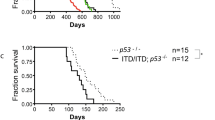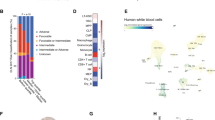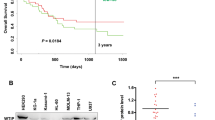Abstract
PU.1 downregulation within hematopoietic stem and progenitor cells (HSPCs) is the primary mechanism for the development of acute myeloid leukemia (AML) in mice with homozygous deletion of the upstream regulatory element (URE) of PU.1 gene. p53 is a well-known tumor suppressor that is often mutated in human hematologic malignancies including AML and adds to their aggressiveness; however, its genetic deletion does not cause AML in mouse. Deletion of p53 in the PU.1ure/ure mice (PU.1ure/urep53−/−) results in more aggressive AML with shortened overall survival. PU.1ure/urep53−/− progenitors express significantly lower PU.1 levels. In addition to URE deletion we searched for other mechanisms that in the absence of p53 contribute to decreased PU.1 levels in PU.1ure/urep53−/− mice. We found involvement of Myb and miR-155 in downregulation of PU.1 in aggressive murine AML. Upon inhibition of either Myb or miR-155 in vitro the AML progenitors restore PU.1 levels and lose leukemic cell growth similarly to PU.1 rescue. The MYB/miR-155/PU.1 axis is a target of p53 and is activated early after p53 loss as indicated by transient p53 knockdown. Furthermore, deregulation of both MYB and miR-155 coupled with PU.1 downregulation was observed in human AML, suggesting that MYB/miR-155/PU.1 mechanism may be involved in the pathogenesis of AML and its aggressiveness characterized by p53 mutation.
This is a preview of subscription content, access via your institution
Access options
Subscribe to this journal
Receive 50 print issues and online access
$259.00 per year
only $5.18 per issue
Buy this article
- Purchase on Springer Link
- Instant access to full article PDF
Prices may be subject to local taxes which are calculated during checkout






Similar content being viewed by others
References
Dahl R, Simon MC . The importance of PU.1 concentration in hematopoietic lineage commitment and maturation. Blood Cells Mol Dis 2003; 31: 229–233.
Moreau-Gachelin F, Tavitian A, Tambourin P . Spi-1 is a putative oncogene in virally induced murine erythroleukaemias. Nature 1988; 331: 277–280.
Leddin M, Perrod C, Hoogenkamp M, Ghani S, Assi S, Heinz S et al. Two distinct auto-regulatory loops operate at the PU.1 locus in B cells and myeloid cells. Blood 2011; 117: 2827–2838.
Rosenbauer F, Wagner K, Kutok JL, Iwasaki H, Le Beau MM, Okuno Y et al. Acute myeloid leukemia induced by graded reduction of a lineage-specific transcription factor, PU.1. Nat Genet 2004; 36: 624–630.
Vigorito E, Perks KL, Abreu-Goodger C, Bunting S, Xiang Z, Kohlhaas S et al. microRNA-155 regulates the generation of immunoglobulin class-switched plasma cells. Immunity 2007; 27: 847–859.
O'Connell RM, Rao DS, Chaudhuri AA, Boldin MP, Taganov KD, Nicoll J et al. Sustained expression of microRNA-155 in hematopoietic stem cells causes a myeloproliferative disorder. J Exp Med 2008; 205: 585–594.
Ghani S, Riemke P, Schonheit J, Lenze D, Stumm J, Hoogenkamp M et al. Macrophage development from HSCs requires PU.1-coordinated microRNA expression. Blood 2011; 118: 2275–2284.
O'Connell RM, Zhao JL, Rao DS . MicroRNA function in myeloid biology. Blood 2011; 118: 2960–2969.
Vargova K, Curik N, Burda P, Basova P, Kulvait V, Pospisil V et al. MYB transcriptionally regulates the miR-155 host gene in chronic lymphocytic leukemia. Blood 2011; 117: 3816–3825.
Ramsay RG, Gonda TJ . MYB function in normal and cancer cells. Nat Rev Cancer 2008; 8: 523–534.
Bartkova J, Horejsi Z, Koed K, Kramer A, Tort F, Zieger K et al. DNA damage response as a candidate anti-cancer barrier in early human tumorigenesis. Nature 2005; 434: 864–870.
Epstein CB, Attiyeh EF, Hobson DA, Silver AL, Broach JR, Levine AJ . p53 mutations isolated in yeast based on loss of transcription factor activity: similarities and differences from p53 mutations detected in human tumors. Oncogene 1998; 16: 2115–2122.
Donehower LA, Harvey M, Slagle BL, McArthur MJ, Montgomery CA Jr., Butel JS et al. Mice deficient for p53 are developmentally normal but susceptible to spontaneous tumours. Nature 1992; 356: 215–221.
Jacks T, Remington L, Williams BO, Schmitt EM, Halachmi S, Bronson RT et al. Tumor spectrum analysis in p53-mutant mice. Curr Biol 1994; 4: 1–7.
Zhao Z, Zuber J, Diaz-Flores E, Lintault L, Kogan SC, Shannon K et al. p53 loss promotes acute myeloid leukemia by enabling aberrant self-renewal. Genes Dev 2010; 24: 1389–1402.
Mannefeld M, Klassen E, Gaubatz S . B-MYB is required for recovery from the DNA damage-induced G2 checkpoint in p53 mutant cells. Cancer Res 2009; 69: 4073–4080.
Tanikawa J, Ichikawa-Iwata E, Kanei-Ishii C, Nakai A, Matsuzawa S, Reed JC et al. p53 suppresses the c-Myb-induced activation of heat shock transcription factor 3. J Biol Chem 2000; 275: 15578–15585.
Wattel E, Preudhomme C, Hecquet B, Vanrumbeke M, Quesnel B, Dervite I et al. p53 mutations are associated with resistance to chemotherapy and short survival in hematologic malignancies. Blood 1994; 84: 3148–3157.
Haferlach C, Dicker F, Herholz H, Schnittger S, Kern W, Haferlach T . Mutations of the TP53 gene in acute myeloid leukemia are strongly associated with a complex aberrant karyotype. Leukemia 2008; 22: 1539–1541.
Nakano Y, Naoe T, Kiyoi H, Kitamura K, Minami S, Miyawaki S et al. Prognostic value of p53 gene mutations and the product expression in de novo acute myeloid leukemia. Eur J Haematol 2000; 65: 23–31.
Noel G, DeKoter RP, Wang Q, Hexley P, Ogle CK . Optimization and application of a flow cytometric PU.1 assay for murine immune cells. J Immunol Methods 2012; 382: 81–92.
Neiman PE, Elsaesser K, Loring G, Kimmel R . Myc oncogene-induced genomic instability: DNA palindromes in bursal lymphomagenesis. PLoS Genet 2008; 4: e1000132.
Burda P, Curik N, Kokavec J, Basova P, Mikulenkova D, Skoultchi AI et al. PU.1 activation relieves GATA-1-mediated repression of Cebpa and Cbfb during leukemia differentiation. Mol Cancer Res 2009; 7: 1693–1703.
Pattabiraman DR, Gonda TJ . Role and potential for therapeutic targeting of MYB in leukemia. Leukemia 2013; 27: 269–277.
Abbas HA, Pant V, Lozano G . The ups and downs of p53 regulation in hematopoietic stem cells. Cell Cycle 2011; 10: 3257–3262.
Rao G, Rekhtman N, Cheng G, Krasikov T, Skoultchi AI . Deregulated expression of the PU.1 transcription factor blocks murine erythroleukemia cell terminal differentiation. Oncogene 1997; 14: 123–131.
Pospisil V, Vargova K, Kokavec J, Rybarova J, Savvulidi F, Jonasova A et al. Epigenetic silencing of the oncogenic miR-17-92 cluster during PU.1-directed macrophage differentiation. EMBO J 2011; 30: 4450–4464.
Curik N, Burda P, Vargova K, Pospisil V, Belickova M, Vlckova P et al. 5-azacitidine in aggressive myelodysplastic syndromes regulates chromatin structure at PU.1 gene and cell differentiation capacity. Leukemia 2012; 26: 1804–1811.
Sokol L, Caceres G, Volinia S, Alder H, Nuovo GJ, Liu CG et al. Identification of a risk dependent microRNA expression signature in myelodysplastic syndromes. Br J Haematol 2011; 153: 24–32.
Acknowledgements
Primary support: GACR P305/12/1033 Institutional: UNCE 204021, PRVOUK-P24/LF1/3, SVV-2013-266509, BIOCEV—Biotechnology and Biomedicine Centre of the Academy of Sciences and Charles University (CZ.1.05/1.1.00/02.0109), from the European Regional Development Fund. Other: PB: GAUK 251135 82210, GACR P301/12/P380; MD: GAUK 251070 45410; VP: GACR 305 13-12449P; PL: Leukemia and Lymphoma Research grant.
Authorship Mouse-AML (PB, EK, MD, US), human-AML (VP, AJ, KV), knockdown (PB), FACS (FS, PB), histology (LS), chromatin immunoprecipitation (PB), experimental design (TS, VP), writing (TS, VP, PB, PL).
Author information
Authors and Affiliations
Corresponding author
Ethics declarations
Competing interests
The authors declare no conflict of interest.
Additional information
Supplementary Information accompanies this paper on the Oncogene website
Supplementary information
Rights and permissions
About this article
Cite this article
Basova, P., Pospisil, V., Savvulidi, F. et al. Aggressive acute myeloid leukemia in PU.1/p53 double-mutant mice. Oncogene 33, 4735–4745 (2014). https://doi.org/10.1038/onc.2013.414
Received:
Revised:
Accepted:
Published:
Issue Date:
DOI: https://doi.org/10.1038/onc.2013.414
Keywords
This article is cited by
-
Intricate crosstalk between MYB and noncoding RNAs in cancer
Cancer Cell International (2021)
-
Aberrant chromatin landscape following loss of the H3.3 chaperone Daxx in haematopoietic precursors leads to Pu.1-mediated neutrophilia and inflammation
Nature Cell Biology (2021)



